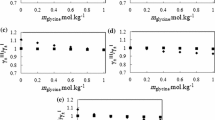Abstract
Values for the mean stoichiometric activity coefficient of NaHS in the system NaHS−H2S−H2O are presented from 12 to 83°C for NaHS concentrations up to 0.2m and for H2S fugacities up to 1 atm. The measurements were made potentiometrically using a novel approach employing three commercially available specific ion electrodes (Na+ glass, H+ glass, and Ag2S) combined to form two cells without liquid junction. The results are described by the equation
t(°C) | D | B° | ΔB |
|---|---|---|---|
10 | 0.223 | 0.075 | 0.442 |
25 | 0.151 | 0.006 | 0.248 |
80 | 0.024 | 0.326 | 0.180 |
Where γ *± is the mean activity coefficient relative to a standard state in which γ *± →1 asm NaHS→0 and\(m_{H_2 S} \to 0\). As expressed by this equation, an increase in the fugacity (or activity) of H2S causes the activity coefficient of NaHS to increase at constantT, P, andm NaHS, the effect becoming more pronounced at lower temperatures. It is suggested that H2S causes the solvent molecules to adopt a quasi-clathrate structure producing partial deslvation and destabilization of Na+ and HS− ions. Hydrogen sulfide is known to form a stable clathrate compound just above 0°C when\(P_{H_2 S} = 1 atm\). The bisulfide ion appears to be a structure promotor based upon the value of the NaHS activity coefficient relative to those of other proton-accepting anions such as OH−, HCO −in3 , and acetate.
Similar content being viewed by others
References
H. P. Stephens and J. W. Cobble,Inorg. Chem. 10, 619 (1971).
R. H. Dinius and L. C. Redding, Completion Report for Office of Water Resources Research Project A-018-ALA (1972).
E. Schmidt and E. Pungor,Proc. Sec. Conf. Appl. Phys. Chem., Veszprem 1, 615 (1971).
W. Giggenbach,Inorg. Chem. 10, 1333 (1971).
A. L. Hammond,Science 139, 128 (1975).
W. P. Bebbington and V. R. Thayer,Chem. Eng. Prog. 55, 70 (1959).
H. L. Barnes and G. K. Czamanske, inGeochemistry of Hydrothermal Ore Deposits, H. L. Barnes, ed. (Holt, Rinehart and Winston, New York, 1967), Chap. 8.
M. B. Goldhaber and I. R. Kaplan, inThe Sea, Vol. V, E. D. Goldberg, ed. (Wiley-Interscience, New York, 1974), Chap. 17.
H. S. Harned and B. B. Owen,The Physical Chemistry of Electrolytic Solutions, 3rd ed. (Reinhold, New York, 1958), p. 431.
H. S. Harned and B. B. Owen,The Physical Chemistry of Electrolytic Solutions, 3rd ed. (Reinhold, New York, 1958), p. 669.
G. N. Lewis and M. Randall,Thermodynamics, 2nd ed., revised by K. S. Pitzer and L. Brewer. (McGraw-Hill, New York, 1961), p. 552.
K. Y. Chen and J. C. Morris,Environ. Sci. Tech. 6, 537 (1972).
G. Schwartzenbach and A. Fischer,Helv. Chim. Acta 169, 1365 (1960).
A. Teder,Ark. Kemi 30, 379 (1968).
A. Teder,Ark. Kemi 31, 173 (1969).
W. E. Morf, G. Kahr, and V. Simon,Anal. Chem. 46, 1538 (1974).
F. L. Herr, Jr., Ph. D. Thesis, University of Maryland, 1975.
E. A. Guggenheim,Philos. Mag. 19, 588 (1935);22, 322 (1936).
J. I. Padova, inModern Aspects of Electrochemistry, Vol. 7, B. E. Conway and J. O'M. Bockris, eds. (Plenum Press, New York, 1972), p. 1.
H. P. Bennetto, D. Feakins, and D. J. Turner,J. Chem. Soc. (A), 714 (1966).
H. P. Bennetto, D. Feakins, and K. G. Lawrence,J. Chem. Soc. (A), 1493 (1968).
E. C. W. Clarke and D. N. Glew,Can. J. Chem. 49, 691 (1971).
G. N. Lewis and M. Randall,Thermodynamics, 2nd ed., revised by K. S. Pitzer and L. Brewer (McGraw-Hill, New York, 1961), p. 381.
H. S. Harned and B. B. Owen,The Physical Chemistry of Electrolytic Solutions, 3rd ed. (Reinhold, New York, 1958), p. 709.
R. A. Robinson and H. S. Harned,Chem. Rev. 28, 419 (1941).
R. W. Gurney,Ionic Processes in Solution (McGraw-Hill, New York, 1973), p. 259.
H. S. Frank and W. Y. Wen,Disc. Faraday Soc. 24, 133 (1957).
F. J. Millero, inWater and Aqueous Solutions: Structure, Thermodynamics, and Transport Properties, R. A. Horne, ed. (Wiley, New York, 1972), Chap. 13, p. 519.
G. R. Choppin and K. Buijs,J. Chem. Phys. 39, 2035 (1963).
O. Y. Samoilov, inWater and Aqueous Solutions: Structure, Thermodynamics, and Transport Properties, R. A. Horne, ed. (Wiley, New York, 1972), Chap. 14, p. 597.
H. S. Frank and M. W. Evans,J. Chem. Phys. 13, 507 (1945).
H. S. Frank and M. Tsao,Annu. Rev. Phys. Chem. 5, 43 (1954).
J. L. Kavanau,Water and Solute-Water Interactions (Holden-Day, New York, (1964).
B. G. Cox and A. J. Parker,J. Am. Chem. Soc. 95, 6879 (1973).
G. Scatchard,Chem. Rev. 19, 309 (1936).
G. N. Lewis and M. Randall,Thermodynamics, 2nd ed., revised by K. S. Pitzer and L. Brewer (McGraw-Hill, New York, 1961), p. 378.
D. W. Davidson, inWater: A Comprehensive Treatise, Vol. 2, F. Franks, ed. (Plenum, New York, 1973), Chap. 3, p. 115.
H. S. Frank and A. S. Quist,J. Chem. Phys. 34, 604 (1961).
D. N. Glew, H. D. Mak, and N. S. Rath, inHydrogen-Bonded Solvent Systems, A. K. Covington and P. Jones, eds. (Taylor and Francis, Ltd., London, 1968).
D. M. Mohilner and H. Nakadomari,J. Electroanal. Chem. 65, 843 (1975).
J. A. Murphy and G. L. Gaines,J. Chem. Eng. Data 19, 359 (1974).
R. A. Robinson and R. H. Stokes,Electrolytic Solutions, 2nd ed. (Butterworths, London, 1962), p. 492.
A. C. Walker, U. B. Bray, and J. Johnston,J. Am. Chem. Soc. 49, 1235 (1927).
Author information
Authors and Affiliations
Rights and permissions
About this article
Cite this article
Herr, F.L., Helz, G.R. Measurement of the activity coefficient of aqueous NaHS to 80°C and 0.2m in the system NaHS−H2S−H2O. J Solution Chem 5, 833–852 (1976). https://doi.org/10.1007/BF01167238
Received:
Revised:
Issue Date:
DOI: https://doi.org/10.1007/BF01167238




